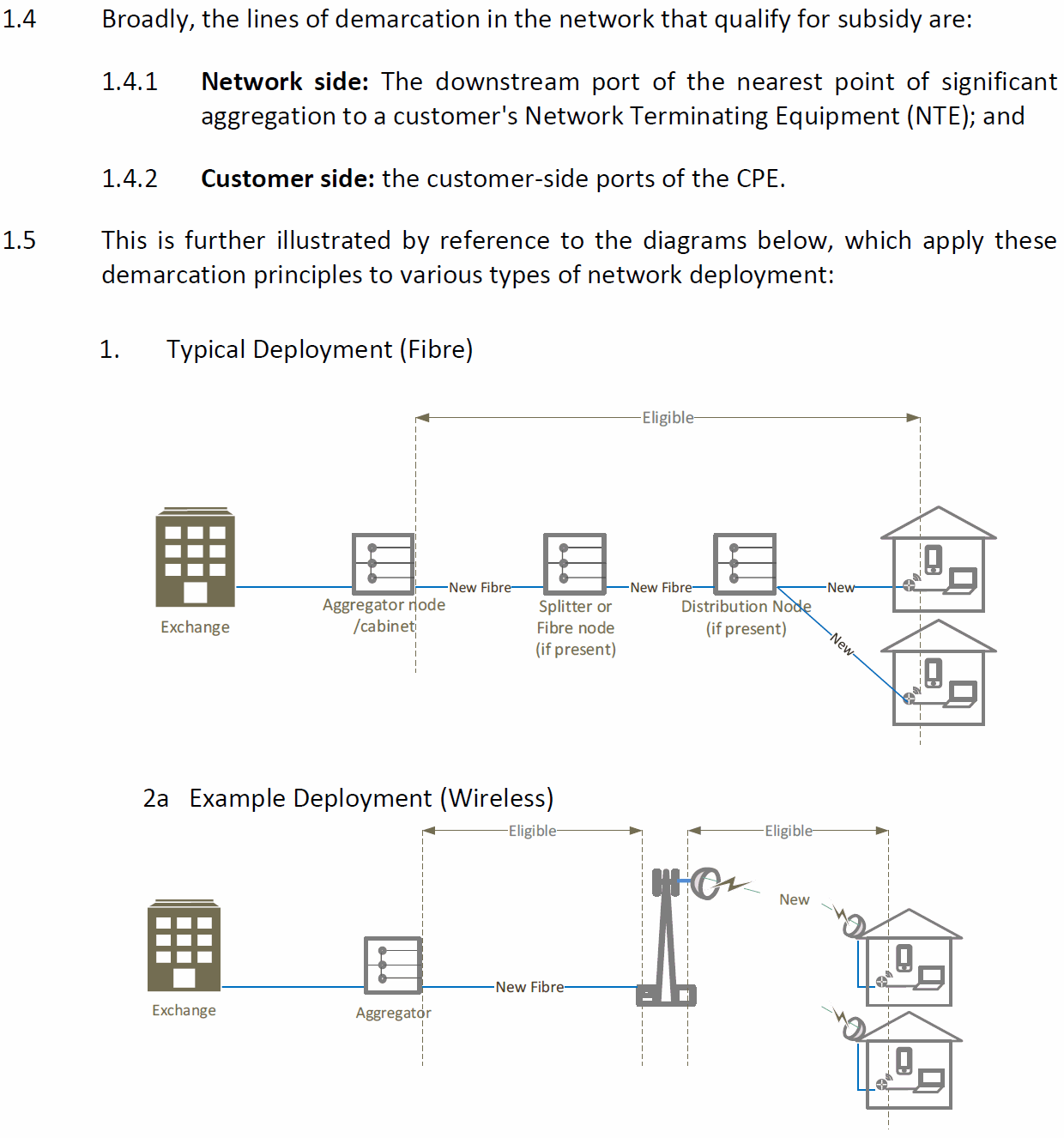New UK Gigabit Voucher Scheme Terms Add Satellite and Caveats UPDATE

As part of their £5bn Project Gigabit programme the UK Government will this week (8th April) start a new rural focused £210m gigabit broadband voucher scheme. A quick look at the new Terms and Conditions for this reveals some key changes, such as the inclusion of satellite, a £100k funding cap on project changes and other caveats.
Just to recap. The “new” voucher scheme is similar to the previous £200m Rural Gigabit Connectivity (RGC) project and thus offers up to £3,500 for businesses, or £1,500 for homes, to help them get a gigabit-capable broadband connection installed.
As we’ve previously reported, the follow-on scheme is designed to complement the gap-funded supplier contracts that Project Gigabit will separately be issuing to network builders. As a result of this the eligibility criteria for new voucher projects has been narrowed so that only those in the remotest areas (e.g. Ofcom’s Area 3) are eligible (unless, of course, another operator already plans to cover the location).
Advertisement
The above decision makes sense given the rural focus of Project Gigabit and the need to keep voucher projects and supplier contracts from clashing in the same intervention areas. In keeping with that ideal, the Government has also just issued some new Terms & Conditions (T&C) to ISPs for the new voucher scheme, which revealed a few other changes (or caveats if you prefer).
As before, these changes are necessary to keep the different sides of Project Gigabit from clashing, but at the same time they may work better for some projects than for others. The new terms are much broader than the old ones and we haven’t picked out all the big changes yet, but here are a few of the key ones.
Key 2021 Gigabit Voucher Scheme Changes (New T&Cs)
➤ We get a clearer definition of a ‘Gigabit Capable Network’.
The terms define Gigabit Capable Network as a “broadband network able to provide a service to end users with a download Access Line Speed capability of at least 1Gbps, with: (a) a Minimum Download Speed of at least thirty three percent (33%) of this download speed; and (b) an upload speed of at least twenty percent (20)% of Minimum Download Speed.”
➤ Satellite has been included.
The final ‘Connectivity Requirements’ under the new terms have added a mention of Satellite, which no doubt reflects the Government’s recent discussions with the new generation of Low Earth Orbit (LEO) based ultrafast broadband suppliers (e.g. Starlink [SpaceX] and OneWeb’s mega constellations).
We have previously predicted that one approach to supporting these would be to include them into a voucher scheme (e.g. to cover the hefty hardware/install costs) and that now appears to be the direction of travel.
Schedule 3 – Connectivity Requirements
1. All connections supported by vouchers under the Scheme must fulfil ALL of the following characteristics:1.1 be Gigabit Capable Network compliant at the time of delivery of the connection without the need for future hardware upgrades or modification (excluding Customer Premises Equipment (CPE) – it is not mandatory to deploy Gigabit Capable Network CPE from the outset if this is not required to deliver service, unless the CPE is embedded into the Network Terminating Equipment (NTE) which must be Gigabit Capable Network compliant);
1.2 deliver a minimum of 30Mbps to the Beneficiary’s Premises; and
1.3 the upgraded broadband service must deliver a “step change” in service which is at least a doubling of speeds compared to the service currently being consumed (either upload or download) or speeds of at least 100Mbps, whichever is lower.
2. Connections which use wireless or satellite technology to meet the Connectivity Requirements are permitted where legal frequencies and technologies are used.
At present it’s hard to see how either Starlink or OneWeb in their current form could be considered as meeting the requirement for a “Gigabit Capable Network compliant at the time of delivery of the connection without the need for future hardware upgrades or modification.”
However, Starlink expects to reach speeds of 300Mbps+ by the end of this year and there has even been some debateable talk about achieving 10Gbps a few years down the line (here). As such we could see SpaceX squeezing into this criteria in the near future. Hopefully SpaceX will also have solved their problems with connection stability by then (disconnections are still far too common for some users).
Meanwhile we don’t yet know where OneWeb, which will send their signal to a central community distribution point (using fixed wireless to connect homes), will sit in all this. OneWeb has significantly fewer LEOs and may struggle to achieve the sort of ultrafast and gigabit style speeds expected above, but we’ll know more when their early commercial beta services start to go live in November 2021.
➤ Top-Up funding is back.
As before, local authorities and devolved governments will be able to boost the value of the aformentioned vouchers by providing additional public investment as a top-up. At the time of writting none of the local bodies have confirmed their final plans for this, but we expect voucher boosts to re-emerge in many areas just like they did in the prior scheme (e.g. Wales).
➤ Voucher funding is more restricted.
The new scheme appears to place tighter restrictions on what parts (costs) of a network deployment can be supported by the public funding they provide. For example, certain headend kit, street cabinets and backhaul links may not be eligible. This won’t be such an issue when it comes to funding the expansion of existing networks, but other projects may find it more of a hindrance.
A number of diagrams are included to help illustrate all this, but the following two give a reasonable idea of where the eligible parts begin and end for different types of deployment (note: there are several other diagrams in the full terms to cover other types of wireless deployment etc.).
➤ The new scheme appears to impose a £100k funding cap on changes to projects.
The new terms appear to impose a ceiling of £100k funding per project for change requests (the original £500k general project limit still exists). The threshold isn’t necessarily a hard cap, but any changes to a project that go significantly above this level (>5% change in total project cost) will require a review by the Building Digital UK team and that may inject some element of doubt and delay into forward planning.
We’d expect BDUK to be reasonably flexible when weighing the pros and cons of certain builds. We think they’d be unlikely to reject most bigger change requests.
Once again, this may be seen as a way of separating voucher schemes from impacting too much on their larger gap-funded intervention contracts.
At the end of the day the new voucher scheme has a fine line to walk as it needs to avoid conflicting with the bigger gap-funded intervention contracts under Project Gigabit, which inevitably means some restrictions to keep the focus of new vouchers targeted at the right rural areas.
Sadly, the Government’s Gigabit Voucher Scheme Website has been offline for several days while they prepare to launch the new scheme on Thursday (you’ll be able to see the final terms once it’s online), although pre-registration is still possible for existing suppliers.
Advertisement
UPDATE 14th April 2021
DCMS (BDUK) has now furnished us with a response after we attempted to clarify some of the aforementioned changes. On the Satellite change, BDUK confirmed that due to the technical criteria they are NOT “expecting the voucher scheme to fund any satellite connections in the near term” and the main reason for its mention was to ensure a technology neutral approach.
We also sought to clarify the rationale behind BDUK’s decision to restrict some parts of a network build from eligibility for subsidy. This it what we were told:
– The voucher scheme isn’t intended to be a funding route to build core network infrastructure. It is intended to be used by suppliers to supplement their commercial deployment and infill neighbouring uncommercial premises.
– It does this by funding customers the excess construction charges they’ll need to pay in the form of higher connection charges from the supplier because they’re outside of their normal commercial deployment. This way, it remains a subsidy benefiting the consumer.
– If we were to fund the core networks as eligible costs, this would create more uncertainty over whether the network was genuinely commercial or not (absent the voucher scheme) and whether we were subsidising the supplier for its commercial deployment. Suppliers are made aware of this at registration when they sign up to the Ts&Cs.
– As you say, this is different to the gap funded contracts where we contract for coverage in an area and directly subsidise a supplier for their capital costs (core or access) to establish the network in that area.
– One tool may be more or less suitable for any particular area than the other so we need both these tools to achieve our coverage objectives.
Mark is a professional technology writer, IT consultant and computer engineer from Dorset (England), he also founded ISPreview in 1999 and enjoys analysing the latest telecoms and broadband developments. Find me on X (Twitter), Mastodon, Facebook, BlueSky, Threads.net and Linkedin.
« Openreach Restart Big UK ISP Talks for Cheaper FTTP Broadband
























































““broadband network able to provide a service to end users with a download Access Line Speed capability of at least 1Gbps, with: (a) a Minimum Download Speed of at least thirty three percent (33%) of this download speed”
and
“deliver a minimum of 30Mbps to the Beneficiary’s Premises”
Surely the first term says the minimum download speed should be 330Mbps?
I believe that may be reflecting the difference between the main performance requirements and products that consumers can actually take. I don’t think an ISP could, for example, do a 25Mbps package on a 1Gbps capable network – it needs to be a package of at least 30Mbps as the minimum. But yes, the way these things are written can be confusing.
Interestingly, the definition of “gigabit capable network” implies an upload speed capability of at least 66 Mbps (20% of 33% of 1G). By this definition, Virgin Media is not “gigabit capable” – the upload is 52Mbps, even after DOCSIS3.1 upgrades.
This could make it a lot harder for Boris to meet his gigabit coverage target.
Except technically Virgin Media’s future upgrades will be able to more than meet that (D3.1 is only implemented on downstream, but they will do it on upstream), so I doubt BDUK would see it as an obstacle as they have the ‘capability’. But you’re unlikely to see this change until after 2021.
The other catch here is that part or all of Virgin Media’s network may go wholesale in the very near future, which would enable more flexibility in end-user product design.
If I’ve understood correctly (and read between the lines of the government announcement), if the ISP’s backend systems can support blazingly fast speeds, and the ISP/wholesale provider has big fat fibre between their network locations and the town/exchange, it’s “gigabit capable”, it’s just tough luck to the end user who then only gets 33% of that “gigabit” speed? And then only 20% of that already massively below gigabit for the upload.
That said, for people stuck on dialup/slow adsl speed lines, it’s at least going to be an improvement, but it’s far from gigabit if it’s not actually gigabit speeds.
No, I think it’s saying that the last mile must be capable of 1Gbps, with sustained throughput of one third of that. That avoids the opposite of what you describe – gigabit customer connections with not enough backhaul to support throughout.
It avoids the situation where 100 customers all get a gigabit last mile, with only a gigabit of backhaul capacity for them to share. It sets a minimum network standard.
@125us – what backhaul would 100 1G customers require?
Impossible to say without some analytics on customer usage, an understanding of the mix of business and residential customers and a view from the network owner as to how hot they want to run it. 100:1 contention is however likely to be too small.
The 100:1 isn’t the issue so much as having backhaul and access bandwidth so close together.
100 * 1 Gb residential customers would probably never max out 5 Gb so a 10 Gb would be fine for the foreseeable.
Gigabit customers have higher burst requirements but don’t have much greater constant usage. Aside from the odd weirdo obsessed with trying to max out the line downstream all the time and the odd person hosting high bandwidth servers the rest aren’t a big deal.
Hopefully these changes (see below) will resolve the majority of the network connectivity issues you were talking about Mark, since dropouts are a real problem for a lot of services, far more than most users who sign up for the Starlink Beta would probably have realised before hand e.g. zoom/voip/whatsapp calls/remote desktops etc.
https://i.redd.it/1xl7t4obsgr61.png
@neilM – Allowing for the fact it is a Beta, you would expect several Leo’s to be identified in a chain to maintain service, and some indication of the links to the ground stations. How many transponders per satellite and what is the capacity per available transponder?
Some of this information is available via FCC filings.
It also depends on which model of satellite and signal quality. Signals will fall back to lower order modulation, in turn reducing bandwidth, in response to lower signal quality.
Each transponder can go up to 2 GHz down, 1 GHz up and up to 64 QAM modulation if I recall correctly.
My home and business is out “in the sticks” and I attempted to make use of the Gigabit scheme. Out here, it only Openreach or Openreach and then are not interested in providing FTTP here unless there are a number of my neighbours that also want to take it up. My nearest neighbour is half a mile away, and they are fed on a different line to me, so it would be me on my own, and via Cerberus Networks, who no longer seem to operate in my area now, Openreach wanted £13K after the voucher, and according to the quote, I didn’t qualify or wouldn’t receive the full voucher value for some reason.
I’m seriously looking at a cellular based solution as 5G looks much more promising than all of these schemes right now
You may not think it but £13k is actually a fantastic price for where you described you lived. I live around the corner from my FTTP aggregator. It’s around 400 meters given it needs to go down one road and down the other to the hookup point and I was quoted 19k for this after the voucher when I checked in 2018 under Openreach on FTTPod.
I would look at Starlink over 5GHz personally. Both you have to have a receiver installed on the wall to get. 5G is not like 4G.
Mark – I don’t see anything in the T&Cs that suggests project costs are limited to £100K. The only reference to £100K I can see is 14.2 where it talks about changes to projects. The current scheme has a £500K limit per project.
So it looks like the manufacturing costs of Starlink dish are going down (about half way down page below).
https://www.cnbc.com/2021/04/06/spacexs-shotwell-no-plan-for-tiered-starlink-internet-pricing.html
Still pricey from Starlinks point of view, but seems like progress is being made.
Probably doesn’t help that there is a shortage of fab & sub strate production globally as well at the moment.